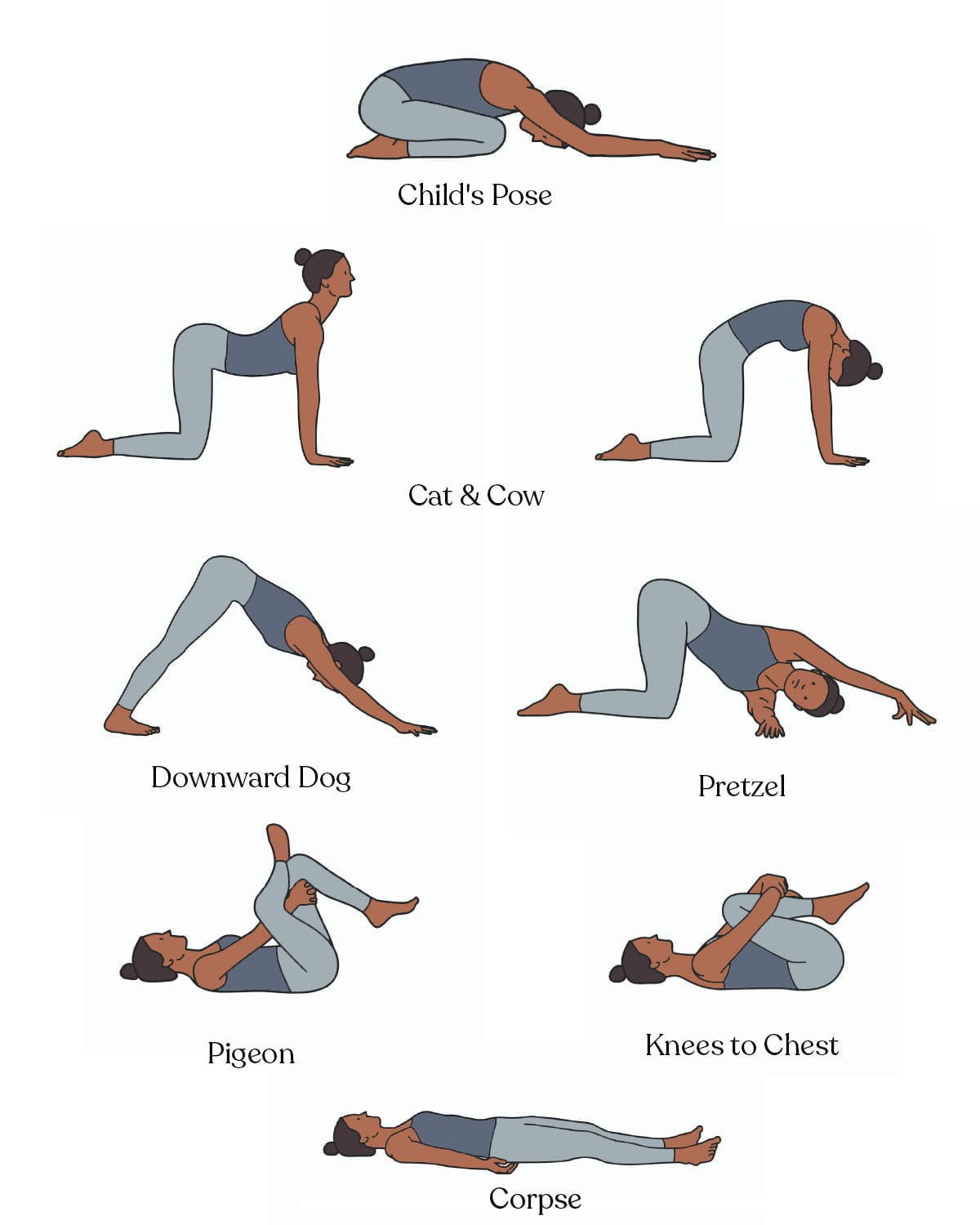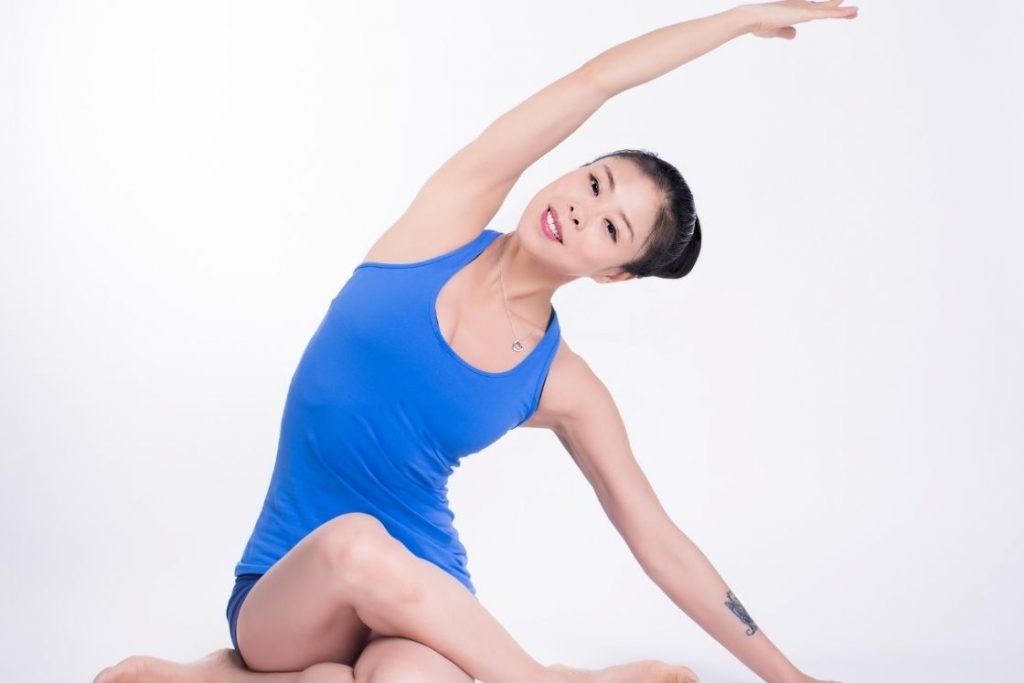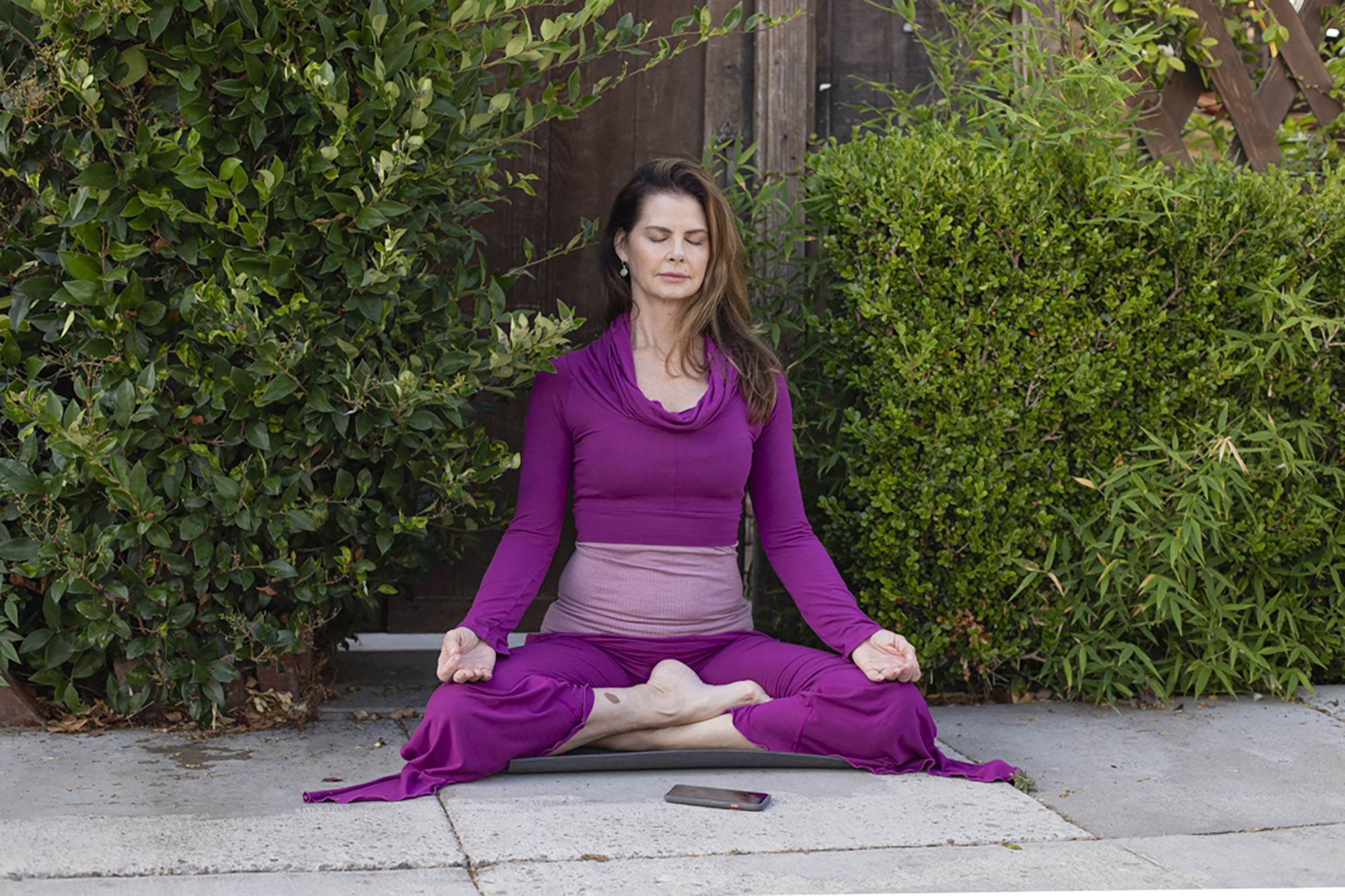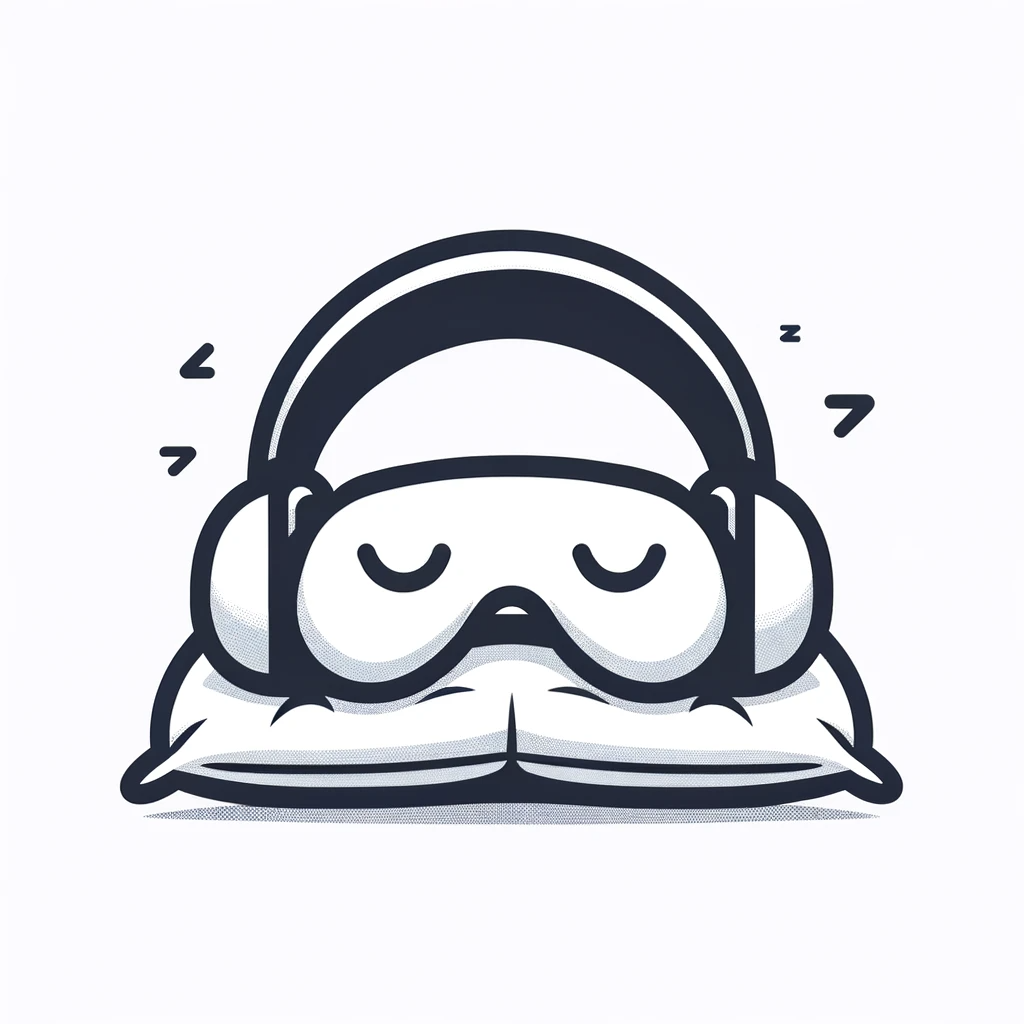
Yoga poses to relieve stress and anxiety
Written: Editor | July 13, 2023

Standing Poses
Mountain Pose and its benefits in stress reduction
Mountain Pose, or Tadasana, is a foundational yoga pose that can help relieve stress and anxiety. It involves standing with feet hip-width apart, grounding down through the feet, and lengthening the spine. This pose promotes stability, balance, and a sense of grounding, which can help calm the mind and reduce stress. It also improves posture and strengthens the muscles of the legs and core. To enhance the relaxation and stress-reducing benefits, you can incorporate deep breathing or meditation while holding the pose.
Tree Pose for improving balance and calming the mind
Tree Pose, or Vrikshasana, is another standing pose that can reduce stress and anxiety. It involves standing on one leg and placing the sole of the opposite foot on the inner thigh or calf. Tree Pose improves balance, focus, and concentration, which can help calm the mind and alleviate anxiety. This pose also strengthens the legs, ankles, and core muscles. To enhance the calming effects, you can try closing your eyes and focusing on your breath while holding the pose.
Warrior Pose sequence to release tension and increase focus
The Warrior Pose sequence, including Warrior I, II, and III, is a powerful sequence that can release tension and increase focus. Warrior I involves lunging forward with one leg, keeping the other leg straight and the arms extended overhead. Warrior II involves a wide-legged stance with arms extended parallel to the ground. Warrior III involves balancing on one leg while extending the opposite leg and torso parallel to the ground.
These poses promote strength, flexibility, and a sense of confidence, which can help reduce stress and anxiety. They also encourage a deep focus on the breath and present moment, allowing you to release tension and find inner peace. Practice these Warrior Poses as a sequence or individually to reap their stress-relieving benefits.
Remember, always listen to your body and modify the poses as needed. If you have any existing injuries or medical conditions, consult with a qualified yoga instructor or healthcare professional before attempting these poses.

Forward Folds and Twists
Yoga is not just a physical practice, it is a deeply transformative experience that can help alleviate stress and anxiety. If you're feeling overwhelmed, incorporating forward folds and twists into your practice can provide relief and relaxation.
Forward Fold to release tension in the back and neck
Forward folding poses like Uttanasana (Standing Forward Bend) or Paschimottanasana (Seated Forward Bend) are excellent for releasing tension in the back and neck. As you fold forward, allow the weight of your head to relax, and focus on breathing deeply into the stretch. This posture can help calm the mind and relieve stress that may be held in the upper body.
Seated Twist for detoxification and relaxation
Seated twisting poses such as Ardha Matsyendrasana (Half Lord of the Fishes Pose) or Parivrtta Janu Sirsasana (Revolved Head-to-Knee Pose) are beneficial for detoxification and relaxation. Twists help to massage the organs and stimulate digestion, promoting the elimination of toxins from the body. They also help to release tension in the spine and improve flexibility. As you twist, focus on lengthening the spine and breathing deeply to enhance the relaxation effect.
Child's Pose for grounding and calming the nervous system
Child's Pose, or Balasana, is a deeply restorative and calming pose that can help ground and calm the nervous system. Begin by kneeling on the floor and slowly lower your torso down, folding forward until your forehead reaches the mat. Extend your arms in front of you or relax them by your sides. Take slow, deep breaths and allow yourself to surrender into the pose. This pose is excellent for relieving stress and anxiety, and it provides a sense of safety and comfort.
Remember, yoga is a personal practice, and it's important to listen to your body and modify the poses as needed. Incorporate these forward folds and twists into your routine to find relief from stress and anxiety, and enjoy the transformative benefits of yoga on your overall well-being.

Backbends and Heart Openers
For those seeking a natural and holistic approach to reducing stress and anxiety, incorporating yoga poses into their daily routine can be highly beneficial. Backbends and heart openers, in particular, are known for their ability to release tension in the body, promote deep breathing, and create a sense of calm. Here are three poses you can try:
Camel Pose for energizing and opening the heart
Camel Pose, also known as Ustrasana, is an invigorating backbend that helps to release stress and anxiety by energizing the body and opening the heart. To practice this pose, kneel on the floor with your knees hip-width apart. Place your hands on your lower back and gently arch your back, allowing your head to fall back and your heart to open up towards the sky. Focus on taking deep breaths and hold the pose for a few breaths before gently releasing it.
Bridge Pose to alleviate stress and anxiety
Bridge Pose, or Setu Bandhasana, is a gentle backbend that helps to alleviate stress and anxiety by stretching and opening the chest, shoulders, and spine. Lie on your back with your knees bent and feet flat on the floor, hip-width apart. Press your feet and arms into the floor, lift your hips up towards the sky, and interlace your fingers underneath your sacrum. Stay in this pose for several breaths, focusing on the gentle stretch in your chest and the grounding sensation in your feet.
Fish Pose for deep relaxation and opening the chest
Fish Pose, or Matsyasana, is a restorative pose that promotes deep relaxation and helps to open the chest. Lie on your back with your legs extended and feet together. Place your hands underneath your hips, palms facing down. Press your forearms and elbows into the floor as you lift your chest towards the sky. Allow your head to gently drop back, supporting it with a folded blanket if needed. Breathe deeply and hold the pose for a few breaths before slowly releasing it.
By incorporating these backbends and heart openers into your yoga practice, you can experience a greater sense of calm, reduce stress and anxiety, and improve overall well-being. Remember to listen to your body and modify the poses as needed, and always consult with a qualified yoga instructor before starting a new exercise routine.

Restorative Poses
Life can get stressful and overwhelming at times. Whether it's work-related pressures, personal challenges, or the daily hustle and bustle, stress and anxiety can take a toll on our physical and mental well-being. One effective way to find calm and relief is through yoga. Here are a few restorative poses that can help you relax and alleviate stress and anxiety.
Corpse Pose for complete relaxation and stress reduction
Also known as Savasana, the Corpse Pose is the ultimate relaxation pose in yoga. It involves lying flat on your back, arms relaxed by your sides, and legs slightly apart. This pose allows your body and mind to completely let go and enter a state of deep relaxation. It helps reduce tension, slow down the heart rate, and calm the nervous system.
Legs Up the Wall Pose for calming the mind and reducing anxiety
The Legs Up the Wall Pose, or Viparita Karani, is a simple and accessible pose that promotes deep relaxation and relieves anxiety. Lie down on your back and place your legs up against a wall, creating an L-shape with your body. This pose helps increase blood circulation to the brain, soothes the nervous system, and induces a sense of calmness and relaxation.
Supported Child's Pose to release tension and relax the body
Child's Pose, or Balasana, is a gentle and restorative pose that can help release tension in the back, shoulders, and neck. To enhance the restorative benefits, use props such as bolsters or pillows to support your upper body and forehead. This pose promotes deep relaxation, stretches the spine, and calms the mind, making it an excellent choice for reducing stress and anxiety.
By incorporating these restorative yoga poses into your daily routine, you can create a space for relaxation and release, allowing your body and mind to find balance and peace. Remember to listen to your body and modify the poses as necessary to suit your comfort level. Take a few moments each day to breathe deeply, let go, and give yourself the gift of self-care through yoga.

Conclusion
Incorporating yoga into your stress relieving routine is a powerful way to calm your mind and body. By practicing specific yoga poses targeted towards stress and anxiety relief, you can experience a greater sense of peace and well-being. Remember to listen to your body and only do what feels comfortable for you. If you have any underlying health conditions or concerns, it's important to consult with a healthcare professional before starting a new exercise routine. With consistency and dedication, you can reap the many benefits of yoga and find peace amidst the chaos of everyday life.
The importance of incorporating yoga into a stress relieving routine
Yoga has been practiced for thousands of years and is known for its ability to reduce stress and anxiety. By combining gentle movements with deep breathing techniques, yoga helps to activate the body's relaxation response, calming the nervous system and promoting a sense of well-being. Regular yoga practice can improve flexibility, strength, and balance while reducing muscle tension and promoting relaxation. It also provides an opportunity to connect with your breath and cultivate mindfulness, which is crucial for managing stress and anxiety.
Tips for creating your own yoga practice
If you're interested in starting your own yoga practice to relieve stress and anxiety, here are a few tips to help you get started:
- Choose a quiet and comfortable space where you can practice without distractions.
- Start with gentle and beginner-friendly poses, gradually working your way up to more advanced poses.
- Focus on deep breathing throughout your practice, inhaling deeply through the nose and exhaling slowly through the mouth.
- Set aside dedicated time each day for your yoga practice, even if it's just a few minutes.
- Consider using props such as yoga blocks, straps, or bolsters to support your practice and make poses more accessible.
- Don't push yourself too hard and always listen to your body. Take breaks when needed and modify poses as necessary.
- Consider attending a yoga class or working with a qualified instructor to learn proper alignment and technique.
Frequently asked questions about yoga poses for stress and anxiety relief
Q: How long do I need to practice yoga to experience stress relief?
A: Even just a few minutes of yoga practice each day can make a difference. However, for optimal benefits, aim for at least 20-30 minutes of practice.
Q: Can yoga help with anxiety?
A: Yes, yoga can be an effective tool for managing anxiety. The combination of movement, breathwork, and mindfulness can help calm the nervous system and reduce anxiety symptoms.
Q: Are there specific yoga poses that are best for stress and anxiety relief?A: Yes, there are several yoga poses that are particularly beneficial for stress and anxiety relief, such as Child's Pose, Downward-Facing Dog, and Legs Up the Wall.
Q: Can I practice yoga if I have physical limitations or injuries?A: Absolutely! Yoga can be modified to accommodate different abilities and physical conditions. It's important to listen to your body and only do what feels safe and comfortable for you.
Q: Is it necessary to meditate during a yoga practice?A: While meditation is often incorporated into yoga practice, it is not necessary. The focus on breath and body awareness during the physical poses can also be meditative in nature.



